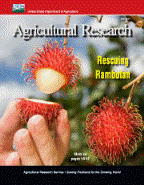U.S. Department of Agriculture: Agricultural Research Service, Lincoln, Nebraska
Date of this Version
1-2013
Document Type
Article
Citation
Agricultural Research, January 2013
Abstract
While being transported in hauling coops on trucks, poultry that have been colonized with bacteria such as Campylobacter can contaminate, through fecal shedding, pathogen-free poultry. Those pathogens can also be passed on to the next group of birds during the next trip, and so forth, unless the cycle is broken.
That’s where Agricultural Research Service microbiologists Mark Berrang and Richard Meinersmann and colleague Charles Hofacre at the University of Georgia in Athens come in. The team has reported a treatment that reduces poultry cross-contamination from transport-cage flooring.
Campylobacter are foodborne pathogens that can be present in raw or undercooked poultry. Since the bacteria are commonly found in the digestive tracts of poultry, they’re readily deposited, through fecal shedding, onto coops and trucks when contaminated animals are transported to processing plants.
Berrang and Meinersmann are in ARS’s Bacterial Epidemiology and Antimicrobial Resistance Research Unit in Athens.
Earlier work has shown that drying soiled or washed cages for 24 to 48 hours could lower or eliminate detectable Campylobacter on cage flooring. But extended drying times are impractical, so the researchers tested the use of hot flowing air to speed the process.
To determine whether the effect was due to heat alone or flowing air alone, hot flowing air was compared with unheated flowing air and static hot air as well as with a control. The numbers of Campylobacter, Escherichia coli, and coliforms on small squares of washed or unwashed fecally soiled transport cage flooring were measured after drying treatments.
Included in
Agriculture Commons, Animal Sciences Commons, Food Science Commons, Plant Sciences Commons

